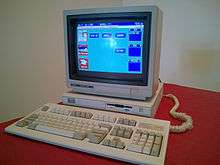Tandy Graphics Adapter
| Release date | 1984 |
|---|---|
| Cards | |
| Entry-level | Tandy Video I |
| High-end | Tandy Video II |
| History | |
| Predecessor | Color Graphics Adapter |
| Successor | Video Graphics Array |


Tandy Graphics Adapter (TGA) is a computer display standard for an IBM PC compatible video adapter that improved on IBM's Color Graphics Adapter (CGA) technology. Whereas CGA could display only four colors at a time at a screen resolution of 320×200 pixels, a TGA adapter could display up to 16 colors.
IBM premiered the new video adapter in the PCjr home computer it announced in 1983. At that time, the company called the adapter the Video Gate Array (not to be confused with the later Video Graphics Array or VGA standard), or CGA Plus. The adapter incorporated the Motorola 6845, an integrated circuit for controlling video.
The PCjr was not popular, but the Tandy 1000 family of home computers were compatible with its video standard and Texas Instruments SN76489-based enhanced sound, and sold well. With built-in joystick ports the 1000 was the best platform for IBM PC-compatible games before the VGA era, and the combination of its graphics and sound became known as "Tandy compatible";[1][2] 28 of 66 games that Computer Gaming World tested in 1989 supported Tandy graphics.[3] The later Tandy 1000 SL and TL models were equipped with an enhanced version of the CGA Plus adapter, capable of displaying 16 colors at an improved resolution of 640×200.[4]
Output capabilities
Tandy Video I, TGA, TCGA, or ECGA
Pre-SL systems have this type of video.[5]
CGA compatible modes:
- 160×200 16 color mode
- 320×200 in 4 colors from a 16 color hardware palette. Pixel aspect ratio of 1:1.2.
- 640×200 in 2 colors. Pixel aspect ratio of 1:2.4
- 40×25 with 8×8 pixel font text mode(effective resolution of 320×200)
- 80×25 with 8×8 pixel font text mode(effective resolution of 640×200)
In addition to the CGA modes, it offers:
- 160×200 with 16 colors
- 320×200 with 16 colors
- 640×200 with 4 colors
Tandy Video II or ETGA
The video on the SL's, TL's, and RL's is known as Tandy Video II or ETGA.[5] It offers all the same modes as Tandy Video I, plus one more non-CGA mode:
- 640x200 with 16 colors
Palette
| Full CGA 16-color palette | |||
|---|---|---|---|
| black #000000 |
0 | gray #555555 |
8 |
| red #AA0000 |
4 | light red #FF5555 |
12 |
| brown #AA5500 |
6 | yellow #FFFF55 |
14 |
| green #00AA00 |
2 | light green #55FF55 |
10 |
| cyan #00AAAA |
3 | light cyan #55FFFF |
11 |
| blue #0000AA |
1 | light blue #5555FF |
9 |
| magenta #AA00AA |
5 | light magenta #FF55FF |
13 |
| light gray #AAAAAA |
7 | white (high intensity) #FFFFFF |
15 |
The full 16 color CGA color palette was available. Some games detected the Tandy hardware and displayed enhanced graphics in Tandy mode while selecting CGA mode, while others specifically offered the option to select "Tandy" graphics.
See also
- Plantronics Colorplus, a graphic board with similar capabilities
- List of 8-bit computer hardware palettes
- List of defunct graphics chips and card companies
References
- ↑ Loguidice, Bill; Barton, Matt (2014). Vintage Game Consoles: An Inside Look at Apple, Atari, Commodore, Nintendo, and the Greatest Gaming Platforms of All Time. CRC Press. pp. 96–97. ISBN 1135006512.
- ↑ Norton, Peter (1984-01-24). "Sound Abilities: The PCjr". PC Magazine. p. 137. Retrieved 23 October 2013.
- ↑ "The Owner's Guide to Tandy 16 Color". Computer Gaming World. August 1989. p. 14. Retrieved 4 November 2013.
- ↑ "PC (PCjr / Tandy 1000 Series)". CVGM.net. Retrieved 19 June 2014.
- 1 2 II.B.5. What is this weird video Tandy has?, Tandy 1000-series FAQ (Version 2.52 / October 25, 2005)
